Marinduque’s value of fisheries production fell by 30.00 percent in 2022
The province of Marinduque experienced a substantial 30.00 percent decline in total value of fisheries production from PhP702,474.84 thousand pesos in 2021 to PhP491,762.95 thousand pesos in 2022. This decline can be attributed to significant reductions across all fisheries subsectors, with commercial fisheries having decreased by 19.45 percent, municipal fisheries by 27.92 percent, and aquaculture having witnessed a considerable decline of 76.94 percent. (Figure 1)
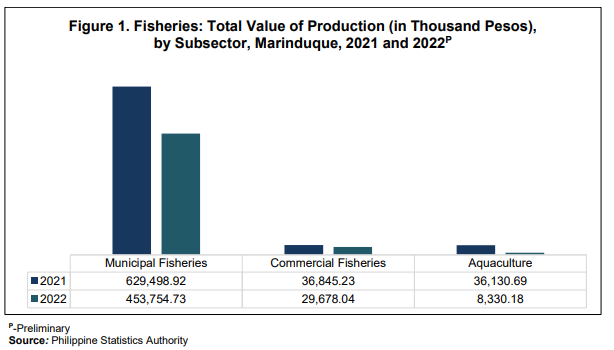
In 2022, municipal fisheries emerged as the dominant contributor to the overall value of fisheries production, accounting for 92.27 percent of it, followed by commercial fisheries at 6.04 percent and aquaculture at 1.69 percent (Figure 3).
A parallel pattern was evident in 2021, with municipal fisheries having a slightly lower share compared to 2022, but still holding the highest share at 89.61 percent of the overall value of fisheries production. Commercial fisheries followed with a share of 5.25 percent, and aquaculture with a 5.14 percent share (Figure 2).
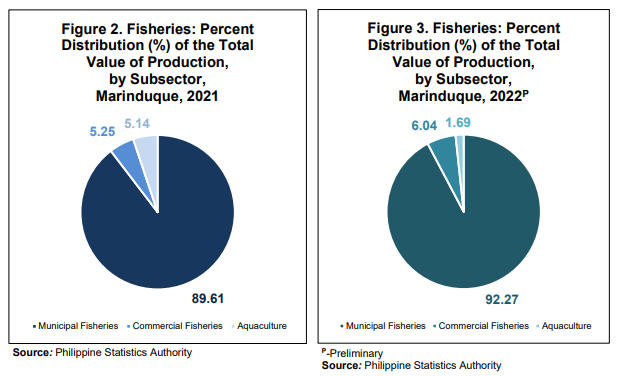
Value of Commercial Fisheries Output Dropped by 19.45 percent
The total value of commercial fisheries production in Marinduque in 2022 amounted to PhP29,678.04 thousand pesos, reflecting a decrease of 19.45 percent from the PhP36,845.23 thousand pesos recorded in 2021.
Among the species within commercial fisheries in 2022, the top three by value were roundscad (galunggong) at PhP13,471.54 thousand pesos (reflecting an increase of 12.98 percent), frigate tuna (tulingan) which amounted to PhP7,666.07 thousand pesos (indicating a significant decline of 23.01 percent), and big-eyed scad (matangbaka) with a value of PhP3,290.22 (showing a substantial decrease of 36.57 percent). On the other hand, caesio (dalagang-bukid) recorded the lowest value at PhP0.20 thousand pesos.
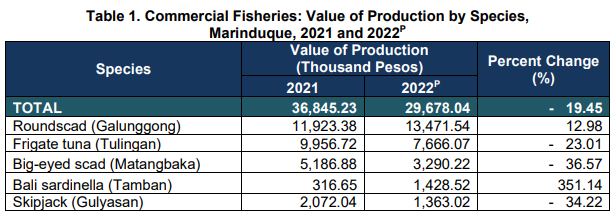
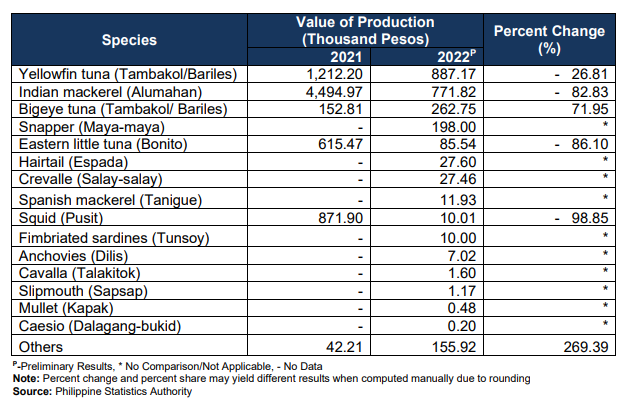
The value of municipal fisheries output dropped by 27.92 percent
In 2022, the total value of municipal fisheries production in Marinduque experienced a significant decrease from PhP629,498.92 thousand pesos to PhP453,754.73 thousand pesos, marking a decline of 27.92 percent. This reduction was primarily driven by a notable decrease in marine municipal fisheries, which fell from PhP616,980.26 thousand pesos in 2021 to PhP435,542.07 thousand pesos in 2022, reflecting a decline of 29.41 percent. In contrast, inland municipal fisheries witnessed growth, increasing from PhP12,518.66 thousand pesos in 2021 to PhP18,212.66 thousand pesos in 2022, representing a notable rise of 45.48 percent. (Figure 4)
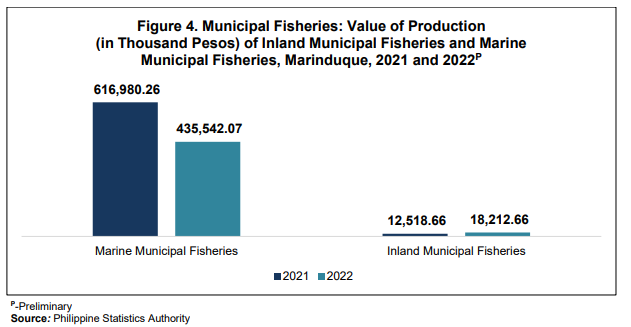
Among the species in marine municipal fisheries in 2022, the top three contributors were frigate tuna (tulingan) at PhP48,662.70 thousand pesos, skipjack (gulyasan) at PhP47,766.60 thousand pesos, and roundscad (galunggong) at PhP43,102.99 thousand pesos, all experiencing substantial decreases, with roundscad showing the most significant decline at 45.48 percent. Certain species demonstrated positive gains, with Porgies (Pargo) showcasing remarkable growth, surging by 375.06 percent from PhP7,549.83 thousand pesos to PhP35,866.54 thousand pesos. Crevalle (salay-salay) also saw notable positive trends, rising by 40.02 percent from PhP7,741.49 thousand pesos to
PhP10,839.36 thousand pesos. Blue crab (alimasag) likewise exhibited a positive gain, increasing by 3.37 percent from PhP6,663.10 thousand pesos to PhP6,887.48 thousand pesos. The lowest recorded value, on the other hand, was for fimbriated sardines (tunsoy) at PhP65.10 thousand pesos (Table 2).
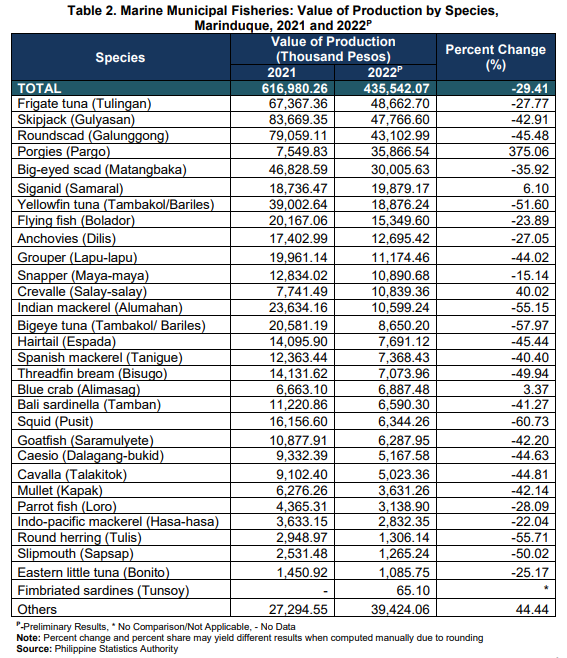
In contrast, inland municipal fisheries in Marinduque excelled in the production of various fish species. The top three contributors to the total value of fisheries production were tilapia at PhP5,201.64 thousand pesos (3,250.28 percent increase), followed by Freshwater goby (Biya) at PhP4,895.89 thousand pesos (1,230.69 percent increase), and Catfish (Hito) at PhP3,253.41 thousand pesos (2,985.56 percent increase). Conversely, Mullet (kapak) recorded the lowest value at PhP223.00 thousand pesos, indicating a decline of 75.67 percent.
On the other hand, crustaceans and mollusks showed a decline. Within the crustaceans group, white shrimp (hipong puti) topped the list with highest value of production at PhP734.29 thousand pesos, reflecting a growth of 35.05 percent. Freshwater shrimp (hipon) followed closely at PhP527.12 thousand pesos but experienced a decline of 58.30 percent. Mud crab (alimango) came in third with PhP218.71 thousand pesos, showing a substantial decrease of 92.33 percent.
In the molluscs category, the top contributor was snail (suso) with PhP147.49 thousand pesos, indicating an increase of 11.96 percent. Clams (kabibi) followed at PhP29.68, but with a decline of 78.66 percent. Shell (Kuhol) and Freshwater Clams (Tulya) recorded values of PhP23.94 thousand pesos and PhP18.58 thousand pesos, respectively.
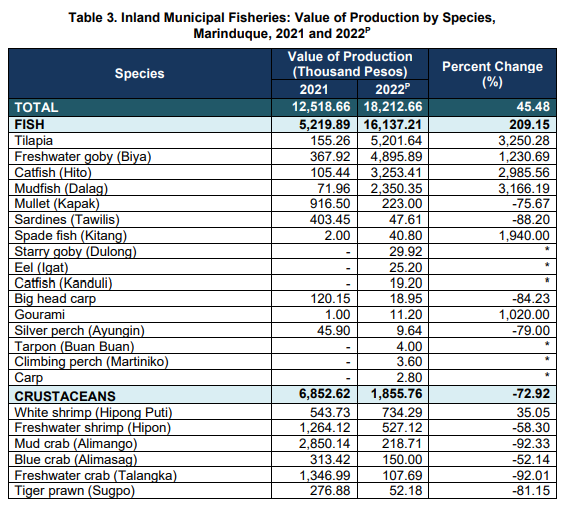

Value of Aquaculture output dropped by 61.01 percent
The aquaculture sector in Marinduque witnessed a considerable decline of 76.94 percent in total value of production from PhP36,130.69 thousand pesos in 2021 to PhP8,330.18 thousand pesos in 2022.
Among the various water environment, brackishwater fishponds experienced a significant decrease of 83.50 percent, with BF - Milkfish declining by 68.37 percent. BF - Mudcrab and BF - Endeavor prawn, however, showed meaningful gains, increasing by 336.77 percent and an impressive 5,134.48 percent, respectively. Meanwhile, BF - Tiger prawn faced an alarming drop of 98.76 percent.
Freshwater fishponds, on the other hand, witnessed a meaningful surge of 3,473.61 percent, primarily driven by considerable increases in FF - Tilapia (3,701.92 percent) and FF - Catfish (376.88 percent).
Seaweed also recorded a significant growth of 66.36 percent, rising from PhP614.71 thousand pesos to PhP1,022.66 thousand pesos. (Table 4)

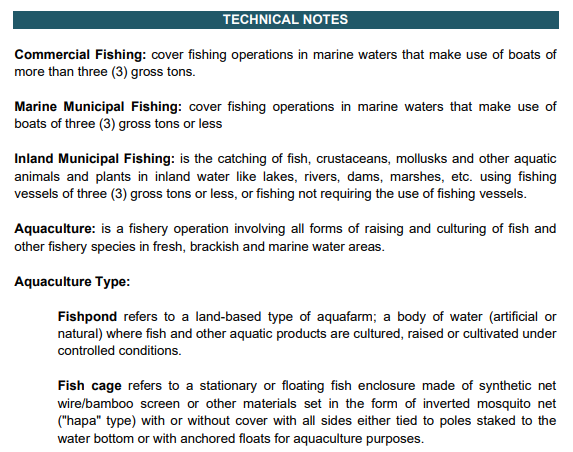
(SGD)GEMMA N. OPIS
Chief Statistical Specialist
PSA PSO Marinduque
GNO/SJRDC

